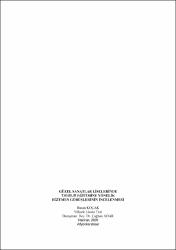| dc.contributor.advisor | Adar, Çağhan | |
| dc.contributor.author | Koçak, Hasan | |
| dc.date.accessioned | 2021-11-25T07:26:12Z | |
| dc.date.available | 2021-11-25T07:26:12Z | |
| dc.date.issued | 2020 | en_US |
| dc.date.submitted | 2020 | |
| dc.identifier.uri | https://hdl.handle.net/11630/9780 | |
| dc.description.abstract | Geçmişi yüzyıllar öncesine dayanan Türk müziği özellikle Osmanlı İmparatorluğu döneminde altın çağını yaşamıştır. Bu dönemde saray tarafından desteklenen Türk müziği besteci ve icracıları, müziğimizin gelişmesi için birçok yeni çalışmalar yapmıştır. Hatta birçok Padişah bestekar da bu alanda besteler yapmış ve enstrüman icra etmiştir. Osmanlı ile başlayan Türk müziğindeki yükseliş 19 ve 20. yüzyıllarda özellikle enstrüman icracılığında kendini göstermeye başlamıştır. Nerdeyse her enstrümanda virtüöz derecesinde Yorgo Bacanos, Cemil Bey, Yusuf Paşa, Vecihe Daryal, Cevdet Çağla, Ruşen Ferit Kam gibi birçok sanatçı yetişmiştir. Bu enstrümanlardan günümüzde icrası az yapılan ve genç nesil tarafından bilinmeyen enstrümanların başında tanbur gelmektedir. Bu enstrümanın öğrencilere genç yaşlarda tanıtılması ve öğretilmesi için güzel sanatlar liselerinde eğitimi verilmeye başlanmıştır.
Bu araştırmada, eğitimcilerimizle yapılan görüşmelerde Milli Eğitim Bakanlığı’nın Güzel Sanatlar Liselerinde uyguladığı tanbur müfredatının içeriği detaylı olarak incelenmiştir. Bunun sonucunda, daha iyi bir eğitim için müfredattaki eksiklikler tespit edilmeye çalışılmıştır. Bununla birlikte müfredatın, konservatuvarların tanbur eğitim derslerinde de yeni tanbur eğitimine başlayacak öğrencilere bir klavuz olması, kullanılan metodlara bir ön hazırlık teşkil etmesi ve bu alanda yazılacak tanbur metodlarına bir örnek olması açısından önemlidir. | en_US |
| dc.description.abstract | Dating back to centuries, Turkish music lived its golden age, particularly during the Ottoman Empire. Turkish music composers and performers supported by The Palace carried out new studies for the development of Turkish music within this period. So much so that, many Sultans contributed to this field through composing and playing instruments. The rise in Turkish music, which started with the Ottoman, pushed its own limits in the 19th and 20th centuries especially in instrument performance. Many artists such as Yorgo Bacanos, Cemil Bey, Yusuf Pasha, Vecibe Daryal, Cevdet Çağla, Ruşen Ferit Kam were trained in almost every instrument. Among these, tanbur is one of the instruments that are played less today and unknown to the younger generation. In order to introducc and teach this instrument to students at a young age, education started in fine arts high schools.
In this rescarch, the content of the curriculum applied by the Ministry of Education at the fine arts high schools during the interviews conducted with Turkish educators were examined in detail. As a result, deficiencies in the curriculum were intended to be identified in the pursuit of a better education. This way, the curriculum is significant in terms of being a guide for students who will start to tanbur education in tanbur training lessons of conservatories. As a preliminary preparation for the methods used and being an example of tanbur methods to be written in this field. | en_US |
| dc.language.iso | tur | en_US |
| dc.publisher | Afyon Kocatepe Üniversitesi Sosyal Bilimler Enstitüsü | en_US |
| dc.rights | info:eu-repo/semantics/openAccess | en_US |
| dc.subject | Tanbur | en_US |
| dc.subject | Eğitim | en_US |
| dc.subject | Müfredat | en_US |
| dc.title | Güzel sanatlar liselerinde tanbur eğitimine yönelik eğitmen görüşlerinin incelenmesi | en_US |
| dc.title.alternative | Investigation of the traİner’s vİews on tanbur education in fine arts high schools | en_US |
| dc.type | masterThesis | en_US |
| dc.department | Enstitüler, Sosyal Bilimler Enstitüsü, Müzik Anasanat Dalı | en_US |
| dc.relation.publicationcategory | Tez | en_US |
| dc.contributor.institutionauthor | Koçak, Hasan | |



















